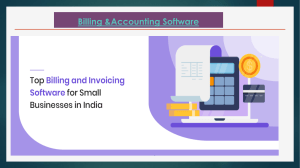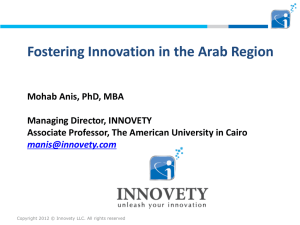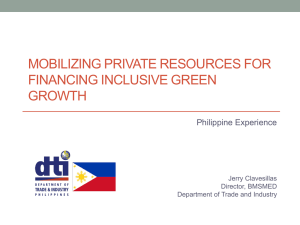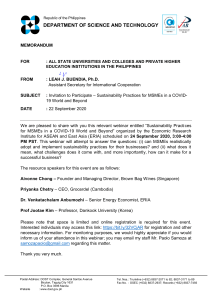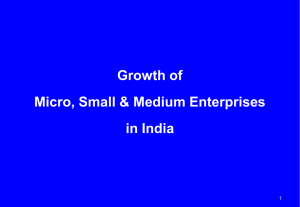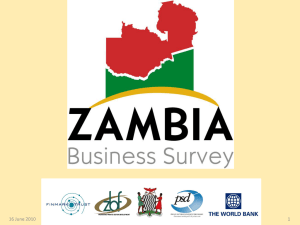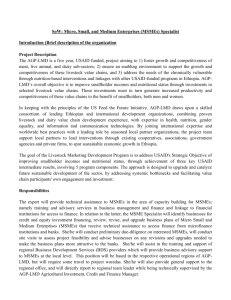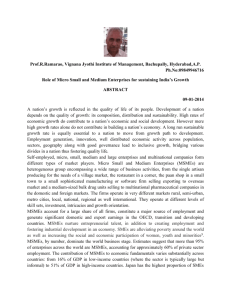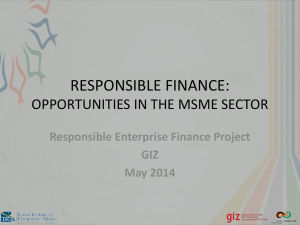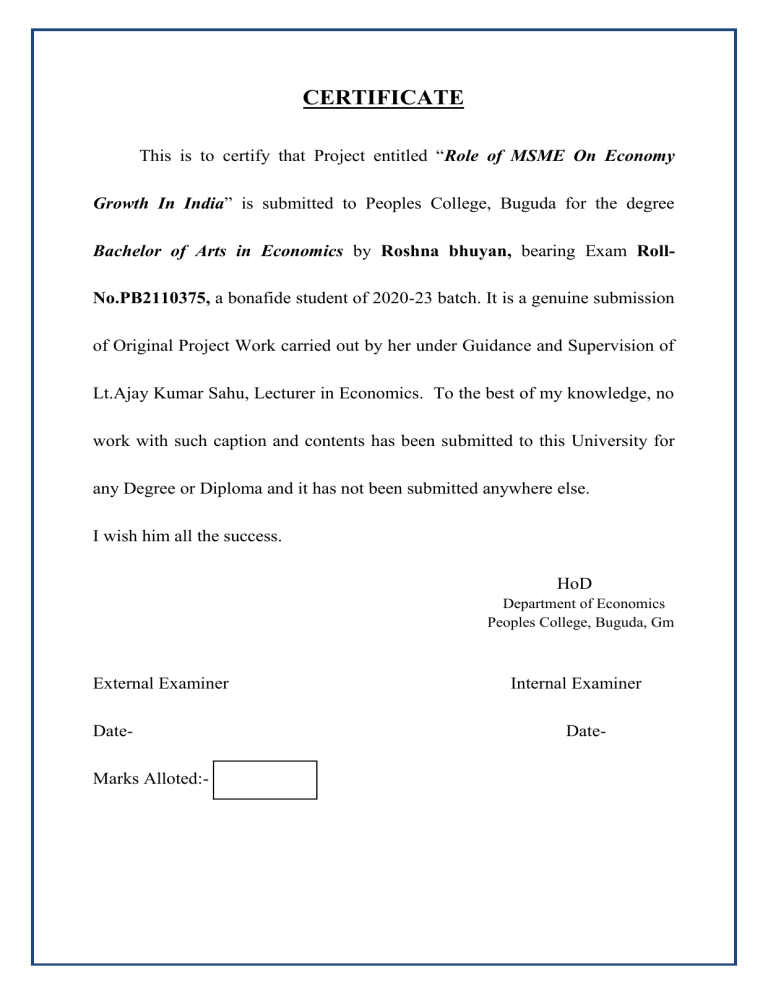
CERTIFICATE This is to certify that Project entitled “Role of MSME On Economy Growth In India” is submitted to Peoples College, Buguda for the degree Bachelor of Arts in Economics by Roshna bhuyan, bearing Exam RollNo.PB2110375, a bonafide student of 2020-23 batch. It is a genuine submission of Original Project Work carried out by her under Guidance and Supervision of Lt.Ajay Kumar Sahu, Lecturer in Economics. To the best of my knowledge, no work with such caption and contents has been submitted to this University for any Degree or Diploma and it has not been submitted anywhere else. I wish him all the success. HoD Department of Economics Peoples College, Buguda, Gm External Examiner DateMarks Alloted:- Internal Examiner Date- Declaration I Roshna Bhuyan of +3 Final Year, Economics Honours-Arts, do hereby declare that the project report entitled “Role of MSME On Economy Growth In India” submitted by me to the Peoples College, Buguda, Ganjam is an authentic work carried out by me for partial fulfilment of the degree Bachelor of Arts in Economics. I further declare that the work reported in this project has not been submitted and will not be submitted by in part or full for the award of any other degree in this institution or any other institution or university. Roshna Bhuyan ( PB2110375 ) ( 16860/2020 ) Acknowledgement I wish to express my profound and sincere gratitude to Sri Ajay Kumar Sahu, Head of the Department of Economics who guided me into the intricacies of this project with matchless magnanimity. I thank my batch mate friends Puja, Chiranjan,abhilash and all others for extending their support during the course of this project. I would be failing in my duty if I don’t acknowledge the guidance rendered during various stages of image interpretation by Sri Anil Sethi, Lecturer in Economics, Dept. of Economics. I am highly grateful to Smt. V. Santoshi Raju, Lecturer in Economics, Dept. of Economics who evinced keen interest and invaluable support in the progress and successful completion of my project work. I am indebted to our honourable Principal Sri. Rajanikanth Dash for their constant encouragement, co-operation and help. Words of gratitude are not enough to describe the accommodation and fortitude which is shown to me throughout my endeavour. Date: Roshna Bhuyan Contents 1.INTRODUCTION .............................................................................................................................................................. 6 1.1Backgound: .................................................................................................................................... 7 1.2: Role of MSMEs in the economic growth of India: ....................................................................... 8 2.LITERATURE REVIEW ...................................................................................................................................................... 9 3.1:OBJECTIVE: ................................................................................................................................................................ 12 3.2: HYPOTHESIS: ............................................................................................................................................................ 12 3.3: SOURCE OF DATA: .................................................................................................................................................... 13 3.4:Types of Data Sources............................................................................................................................................... 15 3.4:METHODOLOGY: ....................................................................................................................................................... 16 4. Data analysis ............................................................................................................................................................... 17 5.CONCLUSION................................................................................................................................................................ 21 6.References: .................................................................................................................................................................. 24 Abstract MSMEs (Micro Small Medium Enterprises) play a very critical role through its contribution towards the economic development of any country and thereby it determines the major economic indicators for a developing nation as such. MSMEs role has been clearly understood as the pillars of our growing economy. MSMEs are flexible with respect to the changes as and when needed by the market and also produce good value added products/services. The MSME sector plays a vital role in the growth of our country. It contributes almost 40% of the gross industrial value added in the Indian economy, It has been estimated that a million rupees of investment in fixed assets in the small scale sector produces 4.62 million worth of goods or services with an approximate value addition of ten percentage points. Since from the inception of five years plan, small sectors have been well promoted and also they have shown a rapid growth rate. As for as manufacturing sectors are considered, its numbers are rapidly increasing over the years since 80's. When we see the growth of MSMEs, It still needs to be tapped effectively in order to get the advantage to the fullest. This paper would study the role of MSMEs in Indian Economy and its impact on the economic development of India as a whole and also how Innovation will be able to contribute for the Indian MSMEs performance. Keywords: MSME, Indian Economy, Economic Development, Innovation 1.INTRODUCTION MSMEs (Micro, Small and Medium Enterprises) are an essential part of the Indian economy and play a crucial role in the economic growth of India. They are considered as the backbone of the Indian economy as they contribute significantly to the country's GDP, employment generation, and exports. MSMEs are defined based on their investment in plant and machinery or equipment. Micro-enterprises have an investment of up to Rs. 1 crore, small enterprises have an investment of up to Rs. 10 crores, and medium enterprises have an investment of up to Rs. 50 crores and MSME stands for Micro, Small and Medium Enterprises. These are small businesses that are owned and operated by individuals or groups of people. MSMEs play a crucial role in the economic development of a country. They contribute significantly to employment generation, income generation, and poverty reduction The government of India has launched several schemes and initiatives to support the growth and development of MSMEs. These include credit guarantee schemes, technology upgradation schemes, marketing assistance schemes, and skill development schemes or MSMEs are considered the backbone of the Indian economy, and their growth and development are crucial for the overall economic growth of the country.Here are some of the ways in which MSMEs contribute to the economic growth of India:1. Employment Generation: MSMEs are the largest employers in India, providing employment to over 110 million people. They create job opportunities in both urban and rural areas, thereby reducing unemployment and poverty.2. GDP Contribution: MSMEs contribute around 30% to India's GDP. They are involved in various sectors such as manufacturing, services, and agriculture, and their contribution to the economy is significant.3. Innovation and Entrepreneurship: MSMEs are known for their innovative ideas and entrepreneurial spirit. They are the breeding ground for new ideas and products, which can lead to the development of new industries and markets.4. Export Promotion: MSMEs are also significant contributors to India's exports. They account for around 40% of India's total exports, and their contribution is expected to increase in the coming years.5. Regional Development: MSMEs are spread across the country, and they play a crucial role in the development of rural and backward areas. They provide employment opportunities and contribute to the overall development of these regions. Micro, Small and Medium Enterprises (MSME) sector has emerged as a highly vibrant and dynamic sector of the Indian economy over the last five decades. MSMEs not only play crucial role in providing large employment opportunities at comparatively lower capital cost than large industries but also help in industrialization of rural &backward areas, thereby, reducing regional imbalances, assuring more equitable distribution of national income and wealth MSMEs are complementary to large industries as ancillary units and this sector contributes enormously to the socio-economic development of the country Ministry of Micro, Small & Medium Enterprises (MSME) envision a vibrant MSME sector by promoting growth and development of the MSME 2 Sector, including Khadi Village and Corr Industries in cooperation with concerned Ministries/Departments, State Governments and other Stakeholders, through providing support to existing enterprises and encouraging creation of new enterprises. As a catalyst for socio-economic transformation of the country, the MSME sector is extremely crucial in addressing the national objectives of bridging the rural-urban divide, reducing poverty and generating employment to the teeming millions.It is therefore,essential that India adoptsa suitable policy framework that provides the required impetus to seize theopportunities andcreate an enabling business environment in order to keep the momentum of growth and holistic development.It is equally important that the MSME sector must address the infrastructural deficiencies and is well empowered to meet the emerging challenges for its sustainable growth and survival in aglobally competitive order.The government has taken several initiatives to promote and support MSMEs, and it is expected that their contribution to the economy will continue to grow in the coming years. 1.1Backgound: MSME stands for Micro, Small and Medium Enterprises. These are small businesses that are registered under the MSME Act of 2006 in India. The definition of MSMEs is based on their investment in plant and machinery or equipment. As per the MSME Act, the following are the definitions of MSMEs: 1. Micro Enterprises: These are businesses that have an investment of up to Rs. 1 crore in plant and machinery or equipment. 2. Small Enterprises: These are businesses that have an investment of up to Rs. 10 crore in plant and machinery or equipment. 3. Medium Enterprises: These are businesses that have an investment of up to Rs. 50 crore in plant and machinery or equipment. MSMEs play a crucial role in the Indian economy as they contribute significantly to employment generation, exports, and overall economic growth. The government of India has launched various schemes and initiatives to support and promote the growth of MSMEs, such as the Prime Minister's Employment Generation Programme (PMEGP), Credit Guarantee Fund Trust for Micro and Small Enterprises (CGTMSE), and the National Small Industries Corporation (NSIC). 1.2: Role of MSMEs in the economic growth of India: 1. Flexibility and Adaptability: MSMEs are known for their flexibility and adaptability to changing market conditions. They can quickly respond to market demands and adjust their production processes accordingly. This makes them an essential part of the supply chain and helps in maintaining the overall economic stability of the country.2. Technology Adoption: MSMEs are increasingly adopting new technologies to improve their production processes and increase efficiency. This has led to the development of new products and services, which has contributed to the overall growth of the economy.3. Financial Inclusion: MSMEs are often located in rural and semi-urban areas, where access to finance is limited. The government has taken several initiatives to promote financial inclusion and provide easy access to credit for MSMEs. This has helped in the growth of these enterprises and contributed to the overall economic growth of the country. 4. Women Empowerment: MSMEs provide significant opportunities for women entrepreneurs to start and run their businesses. This has led to the empowerment of women and contributed to their economic independence. 5. Social Development: MSMEs also contribute to the social development of the country by providing employment opportunities to people from diverse backgrounds. They also support local communities by sourcing raw materials locally and promoting local industries. In conclusion, MSMEs are a critical component of the Indian economy, and their contribution to the economic growth of the country is significant. The government and other stakeholders must continue to support and promote MSMEs to ensure their sustained growth and development. 2.LITERATURE REVIEW Micro, Small and Medium Enterprises (MSMEs) play a crucial role in the economic growth of India. This literature review aims to explore the role of MSMEs in the Indian economy and their contribution to economic growth.According to the Ministry of Micro, Small and Medium Enterprises, MSMEs contribute around 30% of India's GDP and employ over 110 million people. MSMEs are considered to be the backbone of the Indian economy as they are responsible for generating employment, promoting entrepreneurship, and contributing to the country's exports.Several studies have highlighted the importance of MSMEs in the Indian economy. A study by the National Council of Applied Economic Research (NCAER) found that MSMEs have a significant impact on employment generation, income generation, and poverty reduction. The study also found that MSMEs have a positive impact on the overall economic growth of the country.Another study by the Confederation of Indian Industry (CII) found that MSMEs have a significant impact on the country's exports. The study found that MSMEs account for around 40% of India's total exports and have the potential to increase their contribution to the country's exports.The role of MSMEs in promoting entrepreneurship has also been highlighted in several studies. A study by the World Bank found that MSMEs are an important source of entrepreneurship in India and have the potential to create more jobs and contribute to the country's economic growth. However, despite their significant contribution to the Indian economy, MSMEs face several challenges such as lack of access to finance, technology, and skilled labor. Several studies have highlighted the need for the government to provide support to MSMEs in terms of access to finance, technology, and skill development. In conclusion, MSMEs play a crucial role in the economic growth of India. They are responsible for generating employment, promoting entrepreneurship, and contributing to the country's exports. However, MSMEs face several challenges that need to be addressed by the government to ensure their continued growth and contribution to the Indian economy. MSME is the backbone of our Indian economy and it is facilitating a sustained growth over the years both in terms of employment and economic growth. Its role in exports and industrial growth is significant. In spite of these facts, our Indian MSMEs are lagging as compared with devel- oped economies of the world. MSMEs are facing many hurdles and as a result, the expected high growth has become a nightmare. The hurdles can be listed as financial constraint, lack of strategies in marketing, lack of qual- ity, lack of newness or novelty etc. Hence in this paper, attempt has been made by considering Innovation as one of the main construct which might have considerable impact on the performance of MSMEs of Indian origin. Micro, Small and Medium Enterprises (MSMEs) play a crucial role in the economic growth of India. They contribute significantly to the country's GDP, employment generation, and export earnings. Here are some key points from literature reviews on the role of MSMEs in India's economy: 1. Contribution to GDP: MSMEs contribute around 30% to India's GDP, making them a significant contributor to the country's economic growth. (Source: Ministry of MSME) 2. Employment generation: MSMEs are the largest employer in India, providing employment to over 110 million people. (Source: Ministry of MSME) 3. Export earnings: MSMEs contribute around 45% to India's total exports, making them a crucial player in the country's export earnings. (Source: Ministry of MSME) 4. Regional development: MSMEs are concentrated in rural and semi-urban areas, contributing to the development of these regions. They also help in reducing regional imbalances by providing employment opportunities in these areas. (Source: RBI) 5. Innovation and entrepreneurship: MSMEs are known for their innovation and entrepreneurship, which is crucial for the growth of any economy. They are also a source of new ideas and technologies that can be used by larger firms. (Source: World Bank) 6. Access to finance: Access to finance is a significant challenge for MSMEs in India. However, the government has taken several initiatives to address this issue, such as the establishment of the Micro Units Development and Refinance Agency (MUDRA) and the Credit Guarantee Fund Trust for Micro and Small Enterprises (CGTMSE). (Source: Ministry of MSME) Mali (1998) observed that micro, small and medium enterprises have to face increasing competition in the present scenario of globalization. They have to specifically improve themselves in the fields of management, marketing, product diversification, infrastructural development, technological up-gradation. Moreover, new small and medium enterprises may have to move from slow growth area to the high growth area and they have to fonn strategic alliance with entrepreneurs of neighbouring countries. Subrahmanya (2004) highlighted the impact of globalization and domestic refonns on smallscale industries sector by emphasizing that small industry had suffered in terms of growth of units, employment, output and exports. He also suggested that the focus must be turned lo technology development and strengthening of financial infrastructure in order to make Indian mall industry internationally competitive and contribute to national income and employment. Sudan (2005) described the challenges in Micro and Small Scale Enterprises Development and policy issues by raising different questions related to MSMEs. Rathod (2007) analysed the growth and pattern of the SSI sector and identified the reasons for success and failures, evaluated the impact of globalization on SSis and export opportunity and identified the barriers and constraints that SSis were facing lo cope with globalization. Singh, Venna and Anjum (2012) analyzed the performance of MSMEs in India and focused on policy changes which have opened new opportunities for this sector and concluded that MSME sector has made good progress in terms of number of MSME units, production and employment levels. Venkatesh and Muthiah (2012) fouQd that the role of MSMEs in the industrial sector is growing rapidly and they have become a thrust area for future growth. They emphasized that nurturing MSME sector is essential for the economic well-being of the nation. Srinivas (2013) analysed about the performance of MSMEs, their contribution in India's economic growth, identified the number of enterprises, employment in MSMEs and concluded that MSMEs play a significant role in inclusive growth of Indian economy. Overall, MSMEs play a vital role in the economic growth of India. They contribute significantly to the country's GDP, employment generation, and export earnings. However, there are several challenges that need to be addressed to ensure their continued growth and success. 3.1:OBJECTIVE: The objective of MSME (Micro, Small and Medium Enterprises) is to promote and support the growth of small businesses in India. The government of India has implemented various policies and schemes to encourage the development of MSMEs, which are considered as the backbone of the Indian economy. The main objectives of MSMEs are: 1. To promote entrepreneurship and create employment opportunities. 2. To enhance the competitiveness of small businesses in the domestic and international markets. 3. To encourage innovation and technology upgradation in the MSME sector. 4. To provide easy access to credit and finance for MSMEs. 5. To promote sustainable and inclusive growth of the economy. 6. To facilitate the development of backward and forward linkages with other sectors of the economy. 7. To promote exports and increase the share of MSMEs in the global market. 8. To provide a conducive environment for the growth and development of MSMEs. 3.2: HYPOTHESIS: The hypothesis of MSME (Micro, Small and Medium Enterprises) is that the growth and development of small businesses can contribute significantly to the economic development of a country. The following are some of the hypotheses related to MSMEs: 1. MSMEs can create employment opportunities: The growth of MSMEs can lead to the creation of new jobs, which can help in reducing unemployment and poverty. 2. MSMEs can contribute to GDP: MSMEs can contribute significantly to the Gross Domestic Product (GDP) of a country, especially in developing countries. 3. MSMEs can promote innovation: MSMEs can be a source of innovation and new ideas, which can lead to the development of new products and services. 4. MSMEs can promote inclusive growth: MSMEs can help in promoting inclusive growth by providing opportunities to marginalized sections of society, such as women, rural communities, and minorities. 5. MSMEs can contribute to exports: MSMEs can contribute to the export earnings of a country by producing goods and services that are in demand in the global market. Overall, the hypothesis of MSMEs is that they can play a significant role in the economic development of a country by creating jobs, contributing to GDP, promoting innovation, and fostering inclusive growth. MSMEs play a crucial role in the Indian economy as they contribute significantly to employment generation, exports, and overall economic growth. The government of India has launched various schemes and initiatives to support and promote the growth of MSMEs in the country. 3.3: SOURCE OF DATA: The survey results revealed the major financial needs of MSMEs at different stages of their life cycle and the predominant sources of finance used to meet those requirements. Enterprises were not restricted to reporting this data for the current stage of their life cycle but could also report perceptions and experiences for other stages. The values have been computed as the percentage of enterprises reporting the sources of finance used in different stages. Therefore, the total of all reporting enterprises will be different from the total number of enterprises in the sample Start-up stage: Enterprises in this stage reported the use of funds from personal and family sources, from friends, and from public (i.e., government-owned) banks largely forthe purpose of working capital. The other highly reported use of an institutional source was public banks for collateral financing. This implied a high degree of preparedness or risk aversion, or both, while starting an enterprise. Survival stage: Working capital, short-term loans, and overdrafts were the primary purposes for which enterprises in the survival stage sought financial assistance. Finance for working capital was sourced largely from public banks and moneylenders, followed by personal funds and private banks. Private banks were also used to secure short-term loans and overdraft facilities. Enterprises also reported use of moneylenders, though to a lesser extent. The trend of using formal sources or trusted informal sources seemed to continue from that reported by enterprises in the start-up stage. Enterprises in this stage would be looking to pay off debts, for which they would require smooth day-to-day functioning with adequate availability of working capital for the same. Growth stage:Enterprises at this stage required working capital, collateral financing, and short-term loans. Working capital was sourced from public banks, personal and family sources, and to a lesser extent from private and cooperative banks. Collateral financing was obtained from public banks, and to a lesser extent from cooperative banks. Private and cooperative banks were used for obtaining short-term loans, although the use of moneylenders did find a mention. This observation possibly means that enterprises were more focused on their specific financial needs and the sources required to fulfill them. The dominant use of public banks for collateral financing and the use of the banking system and family wealth to meet working capital needs are indicative of the role played by trust in securing this type of finance. As cooperative banks were also mentioned as a source to fulfill multiple financial needs of enterprises at this stage, it needs to be seen if these banks’ policies and procedures are conducive to providing the quick access to short-term finance needed by enterprises in the growth stage. Sustenance stage: Enterprises in this stage reported the use of finance from personal funds, cooperative banks, public banks, and private banks for the purpose of working capital. Cooperative banks were also used for collateral financing and to secure short-term loans. Working capital, collateral financing, and short-term loans seem to dominate the landscape of requirements of enterprises at this stage. This continues the trend, noted above, of using finance from sources that are perceived to be trusted by enterprises. An enterprise in this stage would choose to borrow from sources with which it has well-established relationships and those which could be trusted. Enterprises at this stage reported the dominant use of cooperative banks for working capital, collateral financing, and short-term loans, and it would be interesting to examine the reasons for this prevalence.The data collection process was conducted at the IFC by a team of consultants over a 6-month period from July to December 2018. The process involved primary desk research to collect publicly available data from various official sources for each economy. Separately,the team undertook a data verification process for each economy which included a review by regional IFC financial sector specialists, as well as by peer reviewers from inside andout side of the IFC. The team also conducted numerous data quality checks to ensure the accuracy of the data. 3.4:Types of Data Sources The principal sources of information for the MSME-EI database include the following: • Statistical Institutes, such as National Statistical Committee, the Office of Statistics, and so on; • Ministries, such as the Ministry of Finance, the Ministry of Industry and Commerce, • Central Banks, and so on; • Regional and international organizations, such as Eurostat (of the European Commission), and the Organization for Economic Co-operation and Development (OECD); • Small business promotion government agencies, such as the Small Business Administration; and • Research institutions 3.4:METHODOLOGY: The study was based on primary data collected through a survey. A structured questionnaire was completed by 85 entrepreneurs (business owners) of MSMEs through interviews, mainly during in-person visits but also conducted online and via telephone, largely from selected industrial areas and surrounding suburbs of Bangalore. Most of the enterprises were based in Bangalore (the Silicon Valley ofIndia) and a few were based in Mumbai. In Bangalore, in-person visits to collect datawere made to N.S. Palya Industrial Layout, Peenya Industrial Layout, and Weaver’sColony (power-loom cluster), and the commercial areas of the suburbs of Malleswaram, Rajajinagar, and Avenue Road. Telephone and online interviews wereused to collect data from enterprises located in Mumbai. This study used non-probabilistic judgmental sampling. The data was collected from entrepreneurs who had a bank account (either savings or current) to ensure a minimum financial awareness. The survey was carried out in September and October 2015.Percentage analysis was used to draw inferences from the data collected. This study uses a novel approach in assessing the sources of finance in different stages of the MSME life cycle. The stages of the enterprise that have been defined for this study are (i) start-up, (ii) survival, (iii) growth, and (iv) sustenance. Those in the start-up stage are less than 3 years of age, and those in the survival stage are3–6 years of age. The entrepreneur’s focus in the start-up and survival stages is one stablishing the enterprise in the marketplace and breaking even with regard to initial investments made. Entrepreneurs who have crossed the start-up and survival stages then focus on expanding the reach of their enterprises into newer markets in the growth stage. The business later enters the sustenance stage, when it has an established presence in certain markets and growth has plateaued. Those entrepreneurs whose enterprises are more than 6 years old were encouraged to report sources of finance used and challenges faced in accessing finance in respective stages—growth or sustenance—depending on their own assessment of the stage of their enter prise.A majority of enterprises in the sample were at the sustenance stage, followed by those in the growth stage. The fewest were in the survival stage. Of the 85 enter prises,there were 49 microenterprises, of which 10 were in the start-up stage, 7 in the survival stage, 10 in the growth stage, and 22 in the sustenance stage. The 33 smallenterprises included 4 each in the start-up and survival stages, 15 in the growth stage,and 10 in the sustenance stage. Only 3 medium-sized enterprises participated in the survey, with 2 in the growth stage and 1 in the sustenance stage. 4. Data analysis MSMEs (Micro, Small and Medium Enterprises) play a crucial role in the Indian economy. They contribute significantly to employment generation, exports, and overall economic growth. Here is an analysis of MSMEs in India: 1. Contribution to GDP: MSMEs contribute around 30% to India's GDP and employ over 110 million people. 2. Employment Generation: MSMEs are the largest employers in India after agriculture. They provide employment opportunities to both skilled and unskilled workers, especially in rural areas. 3. Export: MSMEs contribute around 45% to India's total exports. They are involved in the production of a wide range of products, including textiles, leather, handicrafts, and engineering goods. 4. Challenges: MSMEs in India face several challenges, including lack of access to finance, inadequate infrastructure, and limited access to technology. They also face stiff competition from large-scale industries. 5. Government Initiatives: The Indian government has taken several initiatives to support MSMEs, including the introduction of the Micro, Small and Medium Enterprises Development Act, 2006, and the establishment of the National Small Industries Corporation (NSIC) and the Small Industries Development Bank of India (SIDBI). The government has also launched various schemes such as the Credit Guarantee Fund Trust for Micro and Small Enterprises (CGTMSE) and the Prime Minister's Employment Generation Programme (PMEGP) to provide financial assistance to MSMEs. Echoe’s of the Past “On May 9, 2007, the Ministry of Small Scale Industries and the Ministry of Agro and Rural Industries merged to form the Ministry of Micro, Small, and Medium Enterprises as a result of an amendment to the Government of India Rules, 1961.” Today, MSME’s in India contribute nearly 8% of the country's GDP, approximately 45 % of manufacturing output, and 40% of exports. It would not be incorrect to call them the "backbone of the country."In accordance with the Micro, Small, and Medium Enterprises Development Act of 2006, the Government of India established MSME. These businesses are primarily involved in the production, manufacturing, processing, or storage of goods as well as acommodities. The micro to medium sized business are considered as the important sector for the Indian economy and have contributed immensely to the country’s socio-economic development. It not only generates employment opportunities but also works hand-in-hand towards the development of the nation’s backward and rural areas. According to the annual report by the Government (2018-19), there are around 6,08,41,245 MSMEs in India. The analysis of enterprises owned by socially backward groups in each of the three segments of MSME sector reveals that micro sector had 66.42% of enterprises owned by socially backward group, whereas small and medium sectors had 36.80% and 24.94% of enterprises owned by socially backward groups, respectively. This publication brought out an in-depth analysis of data collected on complete enumeration basis from 22.48 lakh enterprises falling under Registered Sector .The report highlighted the operational characteristics of the 15.64 lakh enterprises, its distribution over Sectors and States. For the first time, the detailed features of the Registered MSME were bought out in this report. This report was published in the year 2023. Number Enterprise & Employment generated by MSME from 2006-07 to 2022-23: The MSME sector in India continued to demonstrate significant flexibility in the face of trilling global and internal economic circumstances. The MSMEs sustained the annual progress rate over the last few years. The government of India had begun to make in India concept. The present paper had been concentrated on the part of MSMEs in the Indian economic growth. Progress of Skill Development Programmes Organizations under the ministry are providing skill training to the youths for wage employment and self-employment. They also provide skill up-gradation trainings to existing entrepreneurs and working force to enhance their performances. These training are providing under various schemes such as MSME-TCs, Assistance to Training Institutions (ATI), National SC/ST Hub, Capacity Building, Coir Vikas Yojna – Skill Upgradation & Mahila Coir Yojna, etc. Furthermore, customized demand -driven training courses as per industry requirement are also conducted by organizations under the Ministry. The progress of Skill development programmes conducted by the M/o MSME since 2016-17 to 2022-23 (Data upto October 2022) is given in pie chart below. In conclusion, MSMEs are an essential part of the Indian economy, and their growth and development are crucial for the overall economic growth of the country. The government needs to continue its efforts to support MSMEs and address the challenges they face to ensure their sustained growth and development. 5.CONCLUSION MSMEs (Micro, Small and Medium Enterprises) play a crucial role in the Indian economy. They contribute significantly to employment generation, GDP growth, and exports. The Indian government has taken several initiatives to support and promote the growth of MSMEs, such as providing financial assistance, simplifying regulations, and creating a conducive business environment. However, MSMEs in India face several challenges, such as lack of access to finance, inadequate infrastructure, and limited technological capabilities. These challenges hinder their growth and competitiveness in the global market. To overcome these challenges, the Indian government has launched various schemes and programs, such as the Atmanirbhar Bharat Abhiyan, which aims to make India self-reliant and promote local manufacturing and entrepreneurship. The government has also introduced measures to improve access to finance, such as the Credit Guarantee Fund Trust for Micro and Small Enterprises (CGTMSE) and the Pradhan Mantri Mudra Yojana.In conclusion, MSMEs are an essential component of the Indian economy, and the government's efforts to support and promote their growth are crucial for the country's economic development. However, more needs to be done to address the challenges faced by MSMEs and create a more conducive environment for their growth and competitiveness This work is an attempt of an initial study done on Indian MSMEs under manufacturing sector by taking several variables of Innovation under consideration. We have also proposed a Research framework taking all the differ ent variables identified under Innovation. This is followed by the hypotheses developed to validate the proposed framework and it is also required to test the validity and reliability of the measuring instrument. We will be using a structured questionnaire designed for measuring the constructs of Innovation. We have tested our measuring instrument for its reliability and validity. Our futurework will examine the probable relationships between Innovation dimensions and MSMEs performance and how it affects its performance. It is then followed by an examination of critical factors of the identified constructs affecting the performance of MSMEs MSME sector contributes to employment generation at low capital cost compared to large industries. It helps in industrialization of urban and rural areas, reduces regional imbalance andensures equitable distribution of income and wealth. This research paper has discussed thevarious problems of financing for micro, small and medium enterprises. Through literaturereview it is clear that finance is an essential tool for growth and development of SMEs. Thechallenge of SMEs sector hinders the entrepreneurship development of the country and survivaland growth of MSMEs sector. There are various schemes designed by government for solvingproblems, government efforts has been made for smooth flow of credit to MSMEs sectors butstill MSMEs requires finance. MSMEs address major challenges of the overall Indian economy also, that are unemployment and poverty. By reducing regional imbalances, giving employment to local people living in rural areas, they have done their part to knock-down disparities. Acting as a motivationalfactor for the existing MSMEs and as an aspiration factor for the potential MSMEs, increase in the income of people and the trend of promoting the interests of consumers, there will be various opportunities for MSMEs to play with in the domestic as well as export-market. MSMEsover the years have assumed greater significance in ourburgeoning national economy by contributing to employment generation and ruralindustrialization. This sector possesses enough potential and possibilities to push-button accelerated industrial growth in our developing economy and wellpoised tosupport national programme like ‘Make in India’.This sector has exhibited enoughresilience to sustain itself on the strength of our traditional skills and expertiseand by infusion of new technologies, capital and innovative marketing strategies.Appropriate strategies should be evolved for creation of an enabling ecosystemwhere these enterprises are able to access the benefits meant for themselves undera formal and friendly ecosystem and are further capable of meeting the emergingchallenges of a globally competitive order. The study found that the source of finance utilized by an MSME depends on its current stage in the enterprise life cycle. Four stages were identified: start-up, survival, growth, and sustenance. Enterprises in the start-up stage use funds from personal savings, friends, and family, primarily for the purpose of working capital. They also use public sector banks for working capital and collateral financing. Finance was sourced from trusted informal sources (personal, family, and friends) and trusted formal sources (public banks). Particularly in the case of trusted informal sources, there would be reduced pressure in case of difficulties in repayment. Enterprises in the survival stage use moneylenders and public banks, followed by personal funds and private banks, primarily for the purpose of working capital. Private banks and moneylenders are also used to secure short-term loans. Enterprises in this stage would be looking to break even with regard to investments made and would therefore seek to meet their specific requirements through both informal and formal sources. Short-term requirements were probably sourced from private banks and moneylenders due to their ready availability and quick disbursal.Enterprises in the growth stage use public banks for working capital and collateral financing, and they use private banks for short-term loans. The move toward private banks is possibly due to greater financial need and an increase in the ability of enterprises at this stage to afford the higher cost of finance.Enterprises in the sustenance stage use personal funds, cooperative banks, public banks, and money borrowed from friends, again primarily for working capital. Cooperative banks were also used for short-term loans and collateral financing. Business owners are more aware of meeting specific financial needs from specific sources. The degree of conservatism in the sourcing of finance is exemplified by the use of trusted informal sources (personal wealth and friends) and formal sources (public banks and cooperative banks) for working capital in this stage as well.In a nutshell, sources of finance used across the various stages of the life cycle are limited largely to personal funds; family wealth; friends; moneylenders; and the banking system, comprising public, private, and cooperative banks. The major common challenges faced in accessing finance by enterprises in the start-up and survival stages were difficulty in provision of collateral or a guarantee, lengthy loan processing, and a lack of knowledge about available schemes. Enterprises in both these stages had not yet fully established their businesses and so were not in a position to either provide collateral or security or endure complex loan procedures.the growth stage, the major challenges in accessing finance were a lack of knowledge about available schemes, high service fees for processing loan requests, difficulty in providing collateral or a guarantee, and high interest rates. The financial needs of enterprises seeking to expand and grow into newer markets may be different, and they may be on the lookout for short-term capital that could be borrowed at more competitive rates. This is also a stage in which entrepreneurs would feel the limitationsof not having explored available options in terms of MSME finance schemes due to their lack of awareness in the earlier life-cycle stages of their enterprise. For enterprises in the sustenance stage, the major challenges are the difficulty in providing collateral or a guarantee, procedural complications, lack of knowledge about available schemes, and lengthy processing times for loan applications. A lack of knowledge of available MSME finance schemes, together with collateral requirements for loans, were common challenges in this stage, as in the other stages. It was interesting to find that financial institutions would insist on collateral from enterprises that have established themselves in the market over a period of time, and that goodwill was not considered sufficient. While considering the owner’s educational qualifications, it was found that those business owners with a bachelor’s degree had higher awareness of MSME finance schemes than business owners who had other levels of qualifications. More educated business owners were also more likely to avail themselves of such schemes for their enterprises. 6.References: 1.Bhadauria, A, (2015). Make in India: Need of revamping Linkages of Service sector with MSMEs, International Research Journal of Commerce, Business and Social Sciences (IRJCBSS) Vol III, Issue 12 (I), March 2015, P.p. 92-96, 2.Pratihar, S., & Swain, A.K. (2014). Innovations and Challenges in MSME Sector, DRIEMS Business Review Vol. -1 No.1,P.p.81-85 3.Katyal, K., &Xaviour B. (2015). A Study on MSMEs-Role in Propelling Economic Development of India & A discussion on Current HR Issues MSMEs in India, International Journal of Scientific and Research Publications, Volume 5, Issue 2, February 2015. 4.Basant, M., Das, K., Ramachandran K., and Koshy, A. (2001). The Growth and Transformation of Small Firms in India. New Delhi: Oxford University Press. 5. .Karthikeyan.R and JothiKumar.C. (2014). Improved Reputation Systemfor Wireless Sensor Networks (Wsns), International Journal of Innovations in Scientific and Engineering Research (IJISER),Vol.1,No.3, pp 191-195. 6. MSME Development Act, 2006. Ministry of the District Industry Centers (DIC) MSME,Government of India. 7. Sonia and Rajeev, K. (2009), Globalization and Its Impact on Small Scale Industries India, PCMA Journal of Business, Vol. 1, No. 2, June, 2009, Pp. 135-146. 8.Kalyan, N. and Gugloth, S. (2011). Competitive Performance of Micro, Small and Medium Enterprises in India, Asia pacific journal of social sciences, Pp.128-146. 9.Khalique, Muhammad, Hassan, Md. (2011). Challenges Faced by the Small and Medium Enterprises in Malaysia: Intellectual Capital Perspective, International Journal of Current Research Vol. 33, Issue, 6, June 2011. Pp.398- 401, International Journal of Pure and Applied MathematicsSpecial Issue1739 10.Siringoringo, Hotniar and Prihandoko, Dharma and Kowanda.(2009). Problems Faced by Small and Medium business in exporting products, Delhi Business Review, Jul –Dec 2009. 11.Bharadwaj, A. (2009). Capital crunch hits SMEs, The Economic Times, February, 2009. 12.Kondaiah, C. (2007). Enhancing the Role of Micro & Small Enterprises (MSEs) in Global Value Chains: India’s Initiatives’, 34th International Small Business Congress, Bangkok, Thailand, Nov 11–14 (Mimeo, unpublished) 13. Various Annual Reports of Ministry of Micro, Small And Medium Enterprises, Govt. of India International Journal of Pure and Applied MathematicsSpecial Issue 1740 14. Chandra S. Small Industries Development Organization (SIDO) in Global perspective. aghuUdyogSamachar: Journal of Small Scale Industries. 2004; 28-29(12-2):249-53. 15. Rai D. Development Policies for Micro, Small and MediumEnterprises (MSMES) in India. LaghuUdyogSamachar:Journal of Small Scale Industries, 2009; 34(9-11):3-7. 16. Laforet S. Organizational innovation outcomes in SMEs: Effects of age, size, and sector. Journal of World Business. 2013; 48:490-502. Crossref 17. Navickas V, Kontautiene R. The Initiatives of CorporateSocial Responsibility as Sources of Innovations. Verslas:TeorijairPraktika Business: Theory and Practice. 2013;14(1):27-34. Crossref 18. Teece DJ. Firm organization, industrial structure, and tech- nological innovation. Journal of Economics Behaviour and Organization. 1996; 31(2):193-224. Crossref 19. Nonaka AJ, Takeuchi H. Kreowaniewiedzy w organizacji,Poltext, Warszawa. 2000. 20. Burgelman R, Maidique MA, Weelwright SC Strategic management of technology and innovation. McGraw New York. 2004. 21.Shal, S. (2015). Role of MSMEs in the Growth of Indian Economy. Global Journalof commerce & Management perspective, 4(5), 40-43 22. Bhuyan. U. (2016). A Study on the peefoemance of Micro Small and Medium enterprises(msmes) in india. Global Journal of Management and Business Research:AdministrationandManagement. 16(9), 3223.Vibhuti. S. G., &Barki. G.S. (2016). Role of Micro Small and Medium Enterprises (MSMEs) in Indian Economy. PARIPEX-Indian Journal of Research. 596), 71-73 24.Srivastava, S. (2020).Role of MSME Sector in Indian Economr: A Study with special reference to Gujrat. Practice Business International,13(3), 117-126 25.Shelly. R., Sharma. T &Bawa. S.S. (2020). Role of Micro, Small and Medium Enterprises in Indian Economy. International Journal of Economics and Financial Issues, 10(5), 84-91
